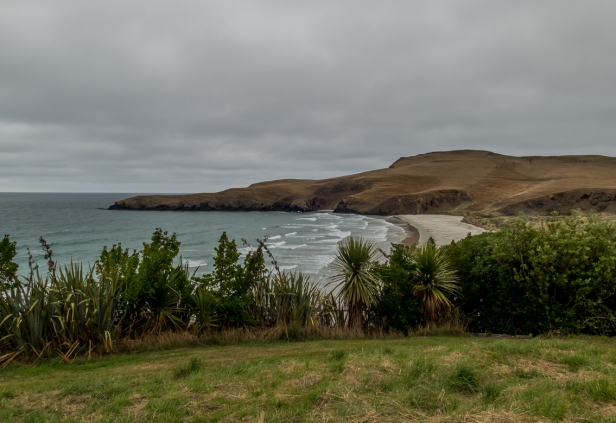
3-4 March 2015. The albatross is a bird of majestic proportions. With a wingspan of three metres they are the largest sea bird, and they own the wild ocean skies: riding the thermals, diving down for food, resting on the water, lifting up into the air again, never touching land. The vast expanse of the open sea and sky is their home. They are more than sailors, being on the ocean for four to six years after their very first launch into the sweeping sky from the nest where they hatched. They are master navigators. They fly as much as 190,000 kilometres a year. They are good luck. They are bad luck.
If an albatross follows a boat it is thought to bring good fortune. In the Samuel Taylor Coleridge poem, The Rime of the Ancient Mariner, the mariner shoots the albatross, the boat undergoes many misfortunes, and the mariner is blamed. His guilt is the albatross around his neck, the burden he carries. It is a cautionary tale of some magnitude. Don’t destroy that which brings you good fortune or you will carry the burden to the end of your days.
Most albatross breed on remote islands, and spend eighty-five percent of their lives at sea. There is a small breeding colony at Pukekura (Taiaroa Head) on New Zealand’s Otago Peninsula near Dunedin. We enter the blind up on the hill, and through the glass, at a distance, we can see the downy chicks on the grass below us.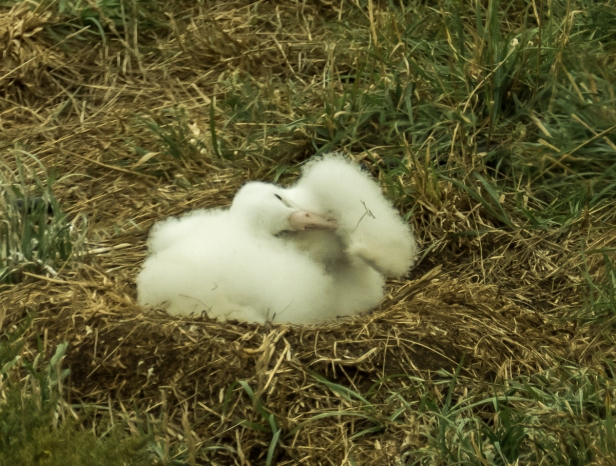

They are about one month old. We see the parents swooping in to feed them. Nine months after hatching, with the aid of a strong wind, the chicks will take off to the ocean and the boundless skies. Mature adults return to land to breed every two years, staying nearly one year to breed and raise a chick, and then returning to the open ocean for the alternate year.
Later in the day we take a boat ride out around the end of the peninsula. The day is overcast and cool, and the water choppy, but the boat, which has an open bow, is sturdy enough. We don all our layers and face the wind and water without hesitation, inhaling the salt air. The boat rocks back and forth as we pass close by the rugged coast of Taiaroa Head, spotting cormorants and other sea birds, and a harem of fur seals basking on the rocks.
Soon we are out past the Head and on open water. Suddenly it seems we are surrounded by albatross, the Northern Royal albatross of Pukekura and two other species. It’s an exhilarating experience to watch their command of the sea and sky. In the most silent way they shout an instinctive grace and perfect oneness with their environment. We are spellbound.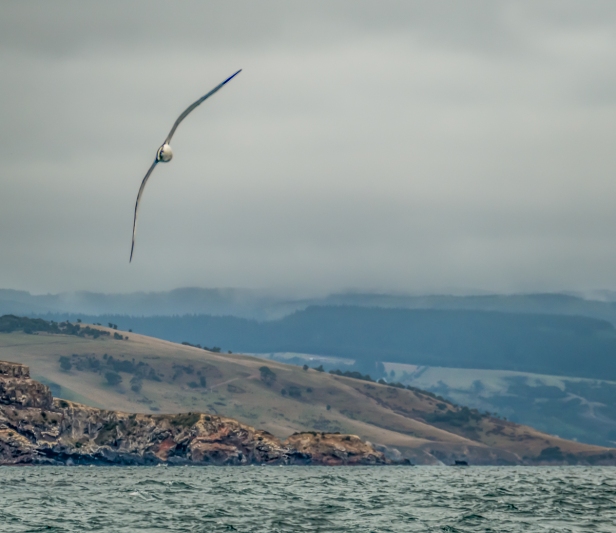
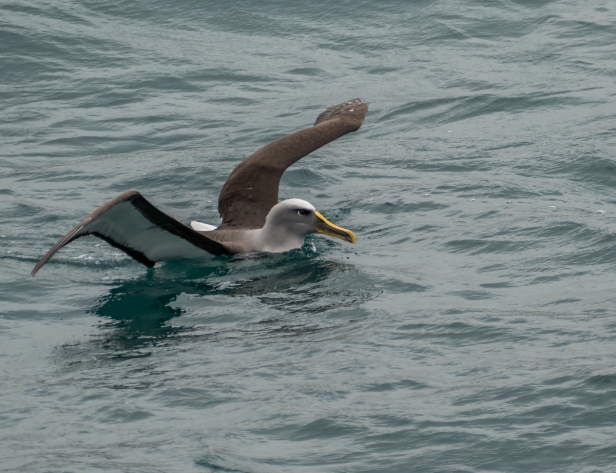
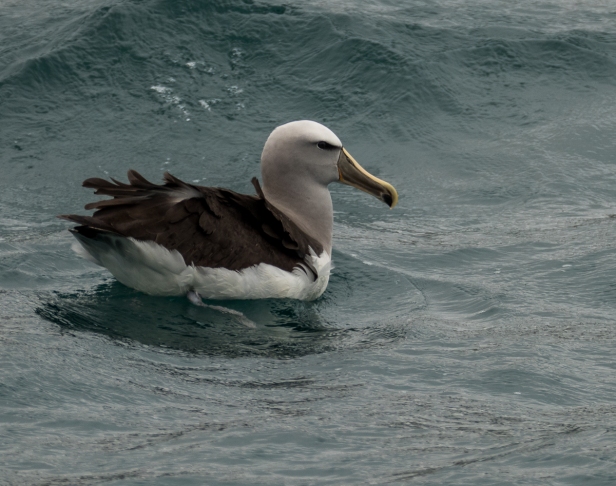
Since 1938, when the first chick successfully fledged, thanks to the devotion and almost constant attention of one Dr Lance Richdale, the colony of Northern Royal albatross at Pukekura has been studied and protected, resulting in the longest continual study and protection of any animal population in the world. The colony, now grown to one hundred birds, is comprehensively managed by the Department of Conservation to ensure its survival and growth.
Otago Peninsula spreads east and then gradually curves north from Dunedin.The landscape doesn’t have the insistent spectacular magnificence of the mountains around Te Anau and Fiordland National Park, but it has its own beauty, serene and soft on a pearl-grey day. 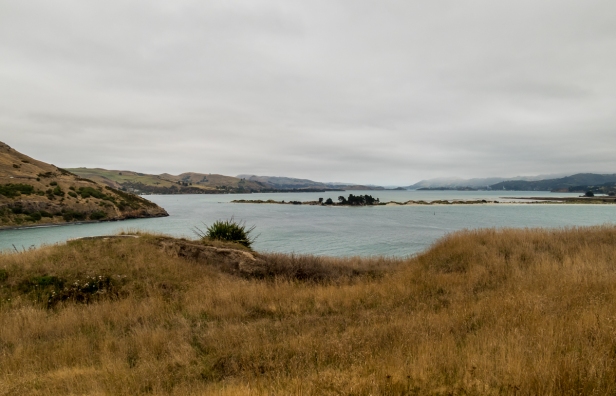


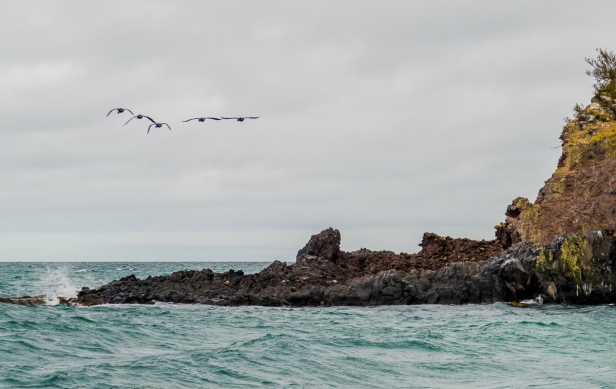
Driving slowly along the winding coast road we encounter boatsheds and fishing boats,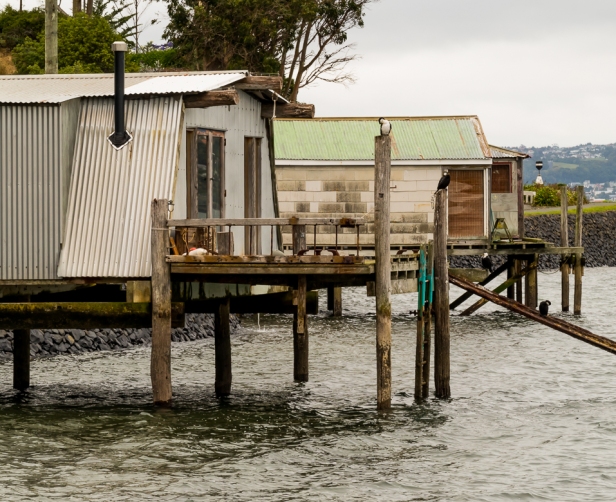
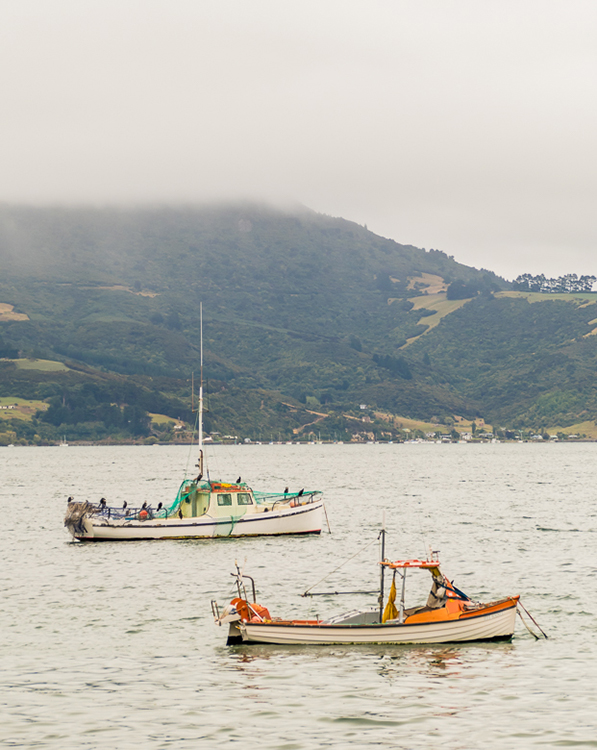
rugged hills, sandy beaches, sheltered bays. We stop and watch the easy grace of a heron as it lands on the rocks close by, and later from a short distance observe a large conference of more than twenty cormorants on one of the boatshed docks.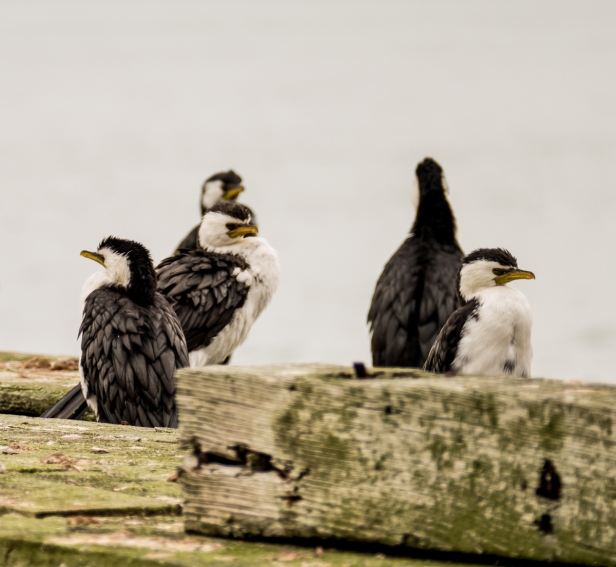
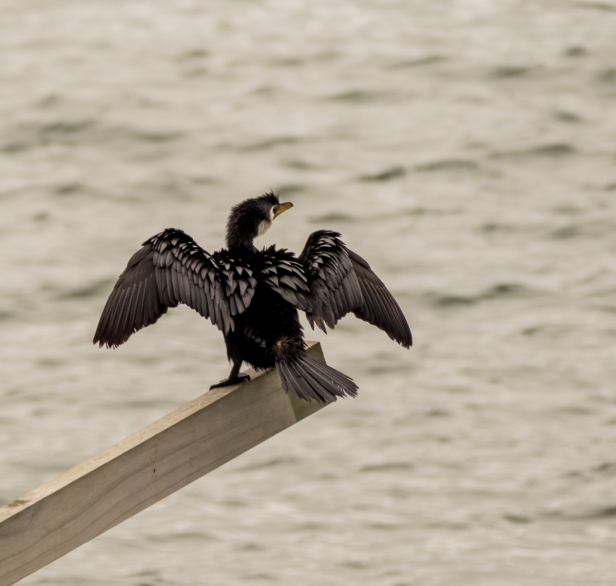
Walking alone along the shore near Taiaroa Head we come across fur seals and a white-faced heron.

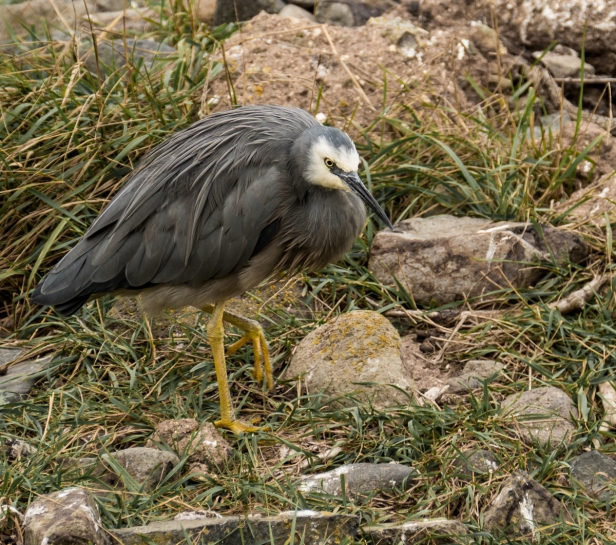
The world’s most endangered penguin is about average in height, for a penguin. Not as small as the tiny Fairy penguins, nor as large as the giant Emperors, they are the fourth tallest penguin with an average height of about 70 centimetres. They are unique to New Zealand, and can be seen along the southern part of the east coast of the South Island, including Otago Peninsula, and on two islands to the south. They are unlike other penguins in two significant ways. They are not social so do not breed and nest in colonies, but instead prefer to be hidden from their neighbours. They like their privacy, so they nest in dense coastal forests and scrub. And they have yellow eyes.
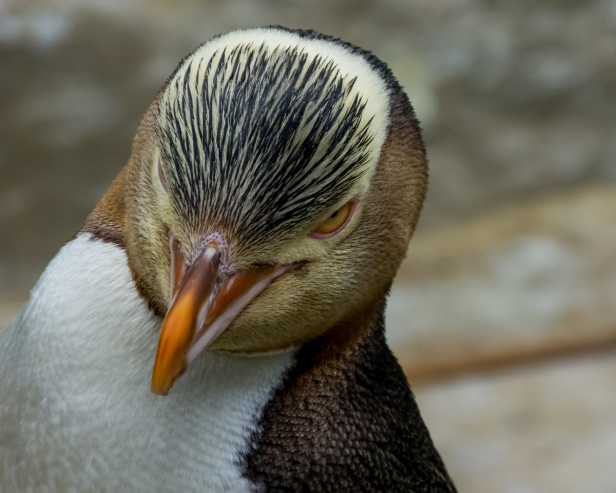

As we creep, bent over and silent, on a stealthy exploration through the bush, concealed by scrub and trenches, our guide points them out. They are solitary – one here, one there, hidden in amongst the low-hanging foliage of the trees.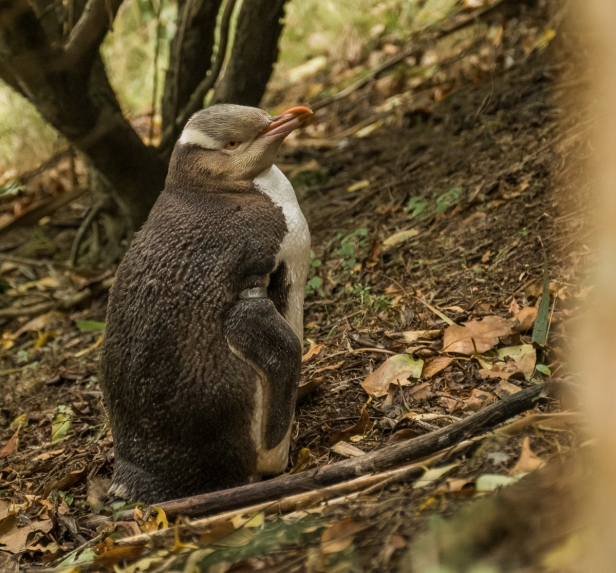
Yellow-eyed penguins, like all penguins, molt. All their feathers. Every year. I had no idea about this and find it a quite startling fact. They spend two or three weeks gorging themselves, diving deep for fish, to gain reserves of fat. Then they stand on land for three to four weeks while the old feathers fall away, and new ones come in. During this time they barely move, and do not eat. They lose about two kilos in weight.
Suddenly our guide indicates we should stop, and there ahead of us are a couple standing together molting.
They are so still. The guide points to a spot where the ground is covered with feathers indicating the two had recently moved about three metres. That’s it. They barely move for about four weeks. It seems extraordinary. Nature is extraordinary. It never would have occurred to me that penguins stand on shore for a month while all their feathers fall out and new ones grow to replace them because the old ones no longer provide the necessary insulation. I suppose it makes sense, that with all that time spent in the water their feathers would get worn out, like an old sweater, but if I’d thought about it at all I’d have assumed they replaced feathers more or less continually, a few at a time, like other birds. Instead, all activity stops for a month and they simply stand. Presumably it is as natural to them as diving for fish.
We have a morning routine on moving days that has become streamlined with much repetition: get up, wash and dress, make breakfast and lunches in the hostel kitchen, pack the car and head out. There’s an easy efficiency to it that usually has us on the road by about ten o’clock.
From Dunedin we drive to Wanaka, just a little north of Queenstown, and think we’ve arrived back in Canada. Lake Wanaka, with its trees and beaches, and surrounding mountains and vineyards, is so like the Okanagan Valley in British Columbia we could as easily be in Vernon or Kelowna where we frequently used to spend our summer holidays.
We’ve definitely arrived back into sunny weather.

And in the warm evening down by the water: a sweet time watching the newest generation of mallards:
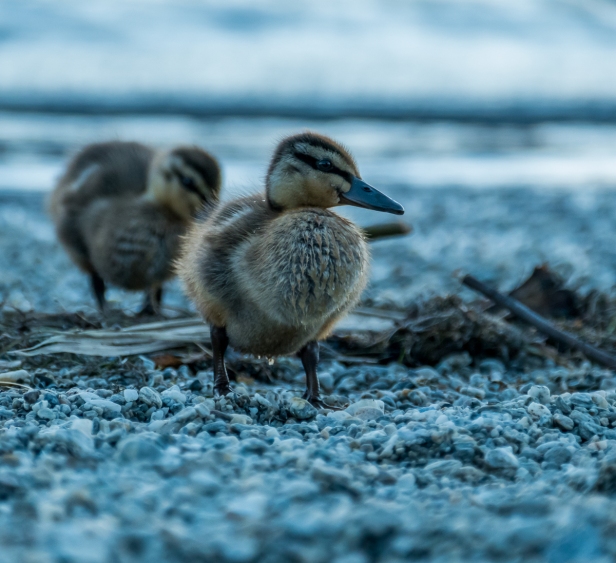
Next post: All about my ongoing quest to be enough.
All words and images by Alison Louise Armstrong unless otherwise noted
© Alison Louise Armstrong and Adventures in Wonderland – a pilgrimage of the heart, 2010-2015.

How wonderful to log on this morning and find yet another post from you, Alison and Don. It’s made my day (as they always do). It’s hard to describe the pleasure your posts bring. Such stunning photography and beautiful writing. Such happiness being able to share your travel experiences. As always, thank you SOOO much.
LikeLiked by 1 person
Thank you so much Ros, and you’re welcome. I’m glad to hear you’re enjoying the blog so much.
Alison
LikeLike
Glorious photos and post about one of my most favorite birds. I remember following them in and out of Antarctica. Whenever I see them, I feel most completely alive! Wonderful, engaging narraive Alsion!
LikeLike
Thanks so much Cindy. We loved the albatross – they are so majestic. It must have been amazing to see them on your Antarctica trip. We looked into doing a trip when we were down in Patagonia, but the schedule didn’t work. Anyway we finally got to see albatross!
Alison
LikeLike
I love learning the reason for the phrases we use: ‘an albatross around your neck’. The story enriches the phrase. One of the photos looks very much like Port Chalmers. Were you near there?
LikeLike
I actually for the first time read the entire poem by Coleridge while researching for this post – it’s a really amazing tale. There’s no explanation as to why the mariner decides to shoot the albatross. But afterwards it gets dire. All the crew die, and come back to haunt him. He finally makes it home and for the rest of his life has to roam the world telling his story to all and sundry as a cautionary tale. It’s old English so not an easy read but I got the gist of it.
We were across the water from Port Chalmers which is a little north of Dunedin, but definitely in the same general area.
Alison
LikeLiked by 1 person
Wonderful post and photos. How lucky you are to be there with all this. I just love the photo of the two beauties molting. A real aww and I’m still smiling. Big hug. ❤
LikeLike
Thanks so much Paulette. Aren’t those funny penguins cute! It was so amazing to see them just standing there, looking all fluffy. Glad it gave you a smile 🙂
Big hug to you too. Hope all is well with you and yours.
Alison ❤
LikeLike
I never knew that penguins get a whole new set of feathers every year! I guess, like you, if I’d thought about it at all, it would be that they replace them continually as other birds do. How fascinating!
LikeLike
I never knew about it either. I was totally stunned. It just seems so unlikely, but there they were right in front of us. At first I thought it was just the Yellow-eyed penguins, but a little research revealed it is all penguins. Amazing!
Alison
LikeLike
Absolutely stunning photos and fascinating information. Shared this on my face book page so my family and my ” birder” friend could enjoy it.
LikeLike
Thanks so much Eileen, I’m glad you enjoyed it. And thank you for sharing – always appreciated.
Alison
LikeLike
These photos seem particularly good, Alison. Maybe it was the muted light from the clouds and the way that allowed the earthen colors to mingle. The fourth picture, with the vertically-hung albatross is striking, and so is the blue-beaked mallard striding over the wet earth near the end.
I am still in a daze thinking about the consciousness of those penguins, such that they can stand so quiet and still for so long. Nature has such profound rhythms– some short, some long, some regular, some irregular– and they are all hints of something we can only taste in the quiet of our own hearts.
Beauty has rhythm and stillness both…
Michael
LikeLike
Maybe the photos seem better because I changed the format of the blog and the photos are now show up about three times bigger than they used to 🙂
And maybe it is because of the muted light of a grey day. In many ways that light can be better than bright sunlight with its harsh edges and deep shadows.
I too am in a daze about the penguins. Another of nature’s mirrors. Be still. Be still. Not only mountains, but small living creatures also know how to be still. A message for us.
Alison
LikeLiked by 1 person
They’re all amazing creatures. And so fascinating about the molting penguins standing practically still for an entire month. I wonder what goes through their minds while they do that, I’m sure they must have some sort of consciousness…
LikeLike
I too have wondered what the penguins think about, but of course I would guess they don’t think, they just be, and that we are anthropomorphizing 🙂
I’d never heard about penguins moulting before and I was completely astonished by it.
I think I would like to experience long periods of that kind of stillness. But not for a whole month!
Alison
LikeLiked by 1 person
stunning photography. your writing was very strong as well. it looks like perfection where you are. makes me yearn to be out in it.
LikeLiked by 1 person
Thank you so much. New Zealand is really beautiful. Everywhere we went it was gorgeous.
Alison
LikeLike
You’re right, Lake Wanaka looks *so* much like the Okanagan!!
LikeLike
Doesn’t it?! We were really struck by the similarity. It’s also much the same around Queenstown which is quite close to Wanaka. We thought we’d been teleported 🙂
Alison
LikeLiked by 1 person
How very, very wonderful to see albatross. I almost feel they exist in another reality. As ever, splendid photos.
LikeLiked by 1 person
Thanks Tish. Yes it was wonderful. We missed the albatross when we were visiting the Galapagos islands so it was great to get to see them in NZ.
Alison
LikeLiked by 1 person
So much interesting information you have supplied in this post. I also was amazed to learn about the penguins standing around for a month moulting. Does this apply to all breeds of penguins or just the yellow eyes? Your photos are so beautiful crisp and clear they sing of the pristine air in the South Island. A delightful post.
LikeLiked by 1 person
Thank you so much pommepal. I’m glad you enjoyed the post. Penguins moulting was completely new to me, and at first I thought it was just the Yellow-eyed, but fortunately I did a little research and apparently it is the same for all penguin species.
Alison
LikeLike
Amazing that interesting fact has never, to my knowledge, been mentioned on any of the documentaries I’ve seen.
LikeLike
Whether it’s the new size or, indeed, the overcast weather, the light in the scenes here is particularly evocative of the New Zealand I remember. There is one photo – of the Otago Peninsula landscape on a “pearl-grey day” – that is achingly beautiful to me. Of course, the wildlife photos are as amazing as always (I’m partial to the fur seal close-up!), but that landscape really grabbed me. Likewise, the boat shed photo is so crisp in that muted light that I can feel the various building materials right on my fingertips! Thanks for yet another wonderful read.
LikeLike
Thank you so much lex. I’m glad you enjoyed the post. I do love that same photo you mentioned, and I also like the opening photograph – they have that same soft light. And for the most part the wild life was very cooperative. Except those darn soaring albatross. They just wouldn’t keep still! 🙂
Alison
LikeLike
I like Don’s photo of the penguin, the up-closeness, the angle of its head, the colors. You da man, Don. And of course, Alison, your photos are cool, too. You da woman. I love the one of the gosling with the seagull (is it?) just out of focus behind him, the water lifting with its feet. And the color. Hey, are your photos bigger, did you change formats? Or what? And yesterday, I saw a photograph in your header…with shadows: freakin’ awesome, dude. Where is that? Where were you to be looking down? I saw an albatross in the Galapagos, with its young, but it was nowhere near as large, I don’t think. Are they smaller in Galapagos, you think? I was trailing way behind the group and guide (taking photos), so didn’t get to hear much of the information. But I think (Now) it was molting because there was “stuff” on the ground. At the time, I thought it came from the baby. So thanks for the guided tour, a few years late!
LikeLike
OMG badfish you are so confused! 🙂
It’s the penguins that moult not the albatross. And the gosling you referred to, being a mallard, is a duckling. 🙂
And I know nothing about the size of albatross in the Galapagos.
Having said all that, and given you a hard time just for the fun of it, thank you for all the nice things you say. Please keep saying them, even if I give you a hard time 🙂
I put that photo of the duckling with the seagull in the background up on FB and it was really popular – lotsa likes.
I’ve added a bunch of new photographs to the header space. They show up randomly and I think the algorithm for that is a bit . . . . . . . random, so you may never again see the photo of shadows. I took it in 2011 in Florence from the top of the Camponile, leaning over, using the monitor instead of the view finder, and holding the camera way out as far as my arm it would go. That way I could get almost directly above the people.
YOU NOTICED! You are the first person to actually notice, or comment that the format is different and that the photos are bigger. Thank you! It took two weeks of research and working with WP techies to achieve and I learned a lot in the process.
Alison
LikeLike
Yeah…confusaled. So many birds, so many names, so little time. I was rushed when I wrote that note–we are changing offices and I had to run. But, I’ve never used the word “gosling” before, why would I call a duck a gosling.
Did you change themes, or modify the old one? Looks like you have two columns where you had three, or at least all that space to the left (except for date, which, now is in the same column, eh). I’m interested in themes because I’m looking for the perfect one for the way I want mine to look. Haven’t quite found it yet. The closest one costs $. I just haven’t had time nor inclination…learning all the stuff. Still don’t know how to use the Reader. It seems…cumbersome, slow.
LikeLike
I didn’t change themes. I spent some part of every day for about ten days looking at and trying out different themes but never finding one that was quite right. In the process I discovered I could modify this one, but only because I pay for my own domain name. I used up all the free gigs so paid for an extra ten and that changes the url to alisonanddon.com and also allows personalisation of the theme. And you’re exactly right, I now have 2 columns instead of three. The tags have been moved to the bottom of the post. I did it through a special CSS forum where I specified how I wanted the blog to look and a lovely WP Happiness Engineer gave me the code to make it happen. I think it makes a huge difference.
The reader is easier than getting email notification of posts from blogs you follow, though I do both. All I know about the reader is that all the new posts of blogs I follow are there, though I’m sure there’s more to it than that.
I dunno. Why would you call a duck a gosling? 🙂
Alison
LikeLiked by 1 person
You lost me at “CSS.” But it’s a cleaner design, bigger. Hopefully I can spend some time this summer figuring things out on the blog. And gosling…jeeesh?
LikeLiked by 1 person
The Otago Peninsula is probably the top spot for wildlife in New Zealand, I love it there. I will be in Wanaka, Queenstown, Fjordland (Routeburn Track) and Mt Cook at the beginning of November and am already so excited for my first trip to the South Island in 6 years.
LikeLike
Wow that sounds like an amazing trip. It’s getting close – only a few months to go. Have a great time!
Alison
LikeLike
Thanks, I will be in Alaska, Hawaii and British Columbia first so I’m looking forward to that too
LikeLike
So you’re really on the move. Happy travels!
A.
LikeLiked by 1 person
Absolutely beautiful photos! Your photography is always wonderful, but this series is over the top wonderful for me.
LikeLike
Thanks so much Angeline. Many people have commented along those lines for this post. I’m especially pleased with the ducklings, and some of the landscapes. The albatross chicks were a challenge being through glass and a long way away. Still, they give some idea of their appearance. It was a wonderful day.
Alison
LikeLike
All your gorgeous bird photos put a smile on my face this morning. Thanks!
LikeLike
Thanks Caroline, and you’re welcome! I’m glad you enjoyed them.
Alison
LikeLike
Quite extraordinary, your close ups of the birds and the seal. What a day! 🙂
LikeLike
Thanks so much Jo. It was a fabulous day!
Alison
LikeLiked by 1 person
A beautiful post, Alison. I love your comments about the Albatross. They bordered on poetry. And the photos, magnificent as always. I feel like I photographed the same ducks at lake Wanaka. It was probably their great, great grand parents. 🙂 –Curt
LikeLike
Thanks so much Curt. I’m quite astounded by albatross, especially the newly fledged that spend 4 to 6 years at sea. It was really a beautiful experience to see them. And equally beautiful, in a completely different way the ducklings. The penguin experience was another thing again. They certainly were not acting in the usual cute penguin way at all.
Alison
LikeLike
I must say, Alison and Don, you two do fun and interesting things with your travels. I would have a hard time knowing how a penguin is supposed to behave. 🙂 –Curt
LikeLike
so wonderful blog. I really enjoy reading your stories with so much beautiful pictures that describes the whole thing. I learned the Albatross, I wish I could see them also.
I asked my sister “Did you know albatross?”
and then she answered me “Yeah’ the perfume we put inside the comfort room?”
Hahaha! we laughed as I showed her the picture of albatross bird. “It’s a bird!”
LikeLike
Thank you so much, I’m so glad you’re enjoying the blog. Funny your sister says albatross is a perfume. It was a clever funny response!
Alison
LikeLiked by 1 person
Hi…I love your site…good theme Chateau, I like the large size photos. Gorgeous photos, fascinating content.
LikeLike
Thanks so much, I’m glad you like it. I have modified the theme. The original Chateau has quite small photos, but I recently got some code from the techies to change it. You have to have premium access (ie pay for space) to be able to do this.
Alison
LikeLiked by 1 person
thanks. I do have premium blogs. Do you mean HTML code
LikeLike
Yes. It’s CSS changes. You go to customize in the menu and you’ll see CSS and that’s where you put in the HTML code that will change the look of the blog. Im my case I moved the edit button and the tags from a left-hand column and put them at the bottom so as to give more room for the text and photos. There’s a CSS section on WP forums where you start a thread saying what changes you want. It took a couple days and then some tweaking, but in the end it was easy.
Alison
LikeLike
OK, I get it…I having only a passing knowledge of HTML and CSS, but I understand. I did do some CSS changes, with color I think. Thanks so much…for the code. I’ll try it out later.
LikeLiked by 1 person
Wow wow wow. Great photos!
LikeLiked by 1 person
Thanks Jane. It was a pretty wow kind of day!
Alison
LikeLike